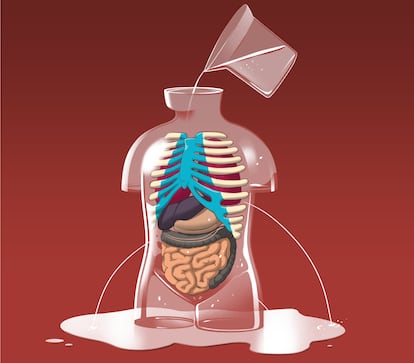The other diabetes: The story of two diseases that were thought to be the same until the 20th century
The symptoms had been described in ancient times, but it was not until the last century when researchers were able to distinguish between the two ailments and identify the causes of each one

Diabetes is one of the most common diseases in Western countries, often related to obesity or poor diet, although it can also have genetic causes. This disease has been known since ancient times, but there were really two diseases.
The Ebers Papyrus, an Ancient Egyptian medical papyrus, described a disease that caused patients to urinate a lot, lose weight and made them feel constantly hungry and thirsty. In classical antiquity, they called this disease “diabetes,” which literally means “passes through.” It is a term supposedly coined by Aretaeus of Cappadocia (other sources indicate that it could also have been Apollonius of Memphis). It refers to the fact that patients need to frequently urinate, i.e. pass liquid. The equivalent medical term today would be polyuria (urinating more than normal). Areteo pointed out that the disease could be due to the fact that patients could be suffering from an extraordinary affection, which melted the flesh of the body and extremities, and turned them into urine. This is how he explained the weight loss.
The 1st century Roman physician Celsus also gave a fairly detailed description of the disease. Galen attributed it to kidney failure, which prevented urine retention. Centuries later it was studied by the Swiss physician, astrologer and alchemist Theophrastus Philippus Aureolus Bombastus von Hohenheim, who called himself Paracelsus because he considered himself superior to Celsus and, understandably, because it was shorter. The Swiss observed that when the patients’ urine evaporated, a white residue was left behind that did not appear in healthy patients. He believed that diabetes was due to the accumulation of this white salt in the kidney. But he was not above Celsus or Galen. No one found the real cause.
In the 17th century, doctor Thomas Willis diagnosed his patients’ illnesses by testing their urine. In this way, he discovered that some of his diabetes patients had urine that was “wonderfully sweet like sugar or honey,” while others, suffering from similar symptoms, did not have sweet-tasting urine. Thus, he coined the terms “diabetes mellitus” (literally diabetes sweetened with honey) and “diabetes insipidus” (tasteless diabetes). And that’s how these two seemingly similar diseases became differentiated.
Today we know that diabetes mellitus, the most common form, is due to a problem with the regulation of blood sugar levels. In the 20th century, thanks to the work of scientists such as Romanian Nicolae Paulescu and the Canadians Frederick Banting and Charles Best, we have discovered the role played by the pancreas and the hormone it secretes — insulin — in regulating blood sugar levels. We know that juvenile diabetes is usually due to deficient insulin production and that, if it appears in adulthood, it is due to the cells’ response to an insulin deficiency. For a long time, insulin-based treatment was very expensive and ineffective, since the only way to obtain the hormone was from a pig’s pancreas. Thanks to the development of genetic engineering, today we can produce human insulin from bacteria or yeast at an affordable price.
And what happened to those who had diabetes, but did not have sweet urine? Well, their blood sugar levels were perfectly normal and so was their insulin levels. Diabetes insipidus is a fairly rare genetic disease that can be caused by damage to the kidneys (nephrogenic) or the hypothalamus (central). Like with diabetes mellitus, the disease is due to a hormone deficiency, but in this case, it is not insulin but rather vasopressin or antidiuretic hormone, which is responsible for maintaining the correct level of fluids in the body. A failure in the hippocampus stops the hormone from being produced, while a failure in the kidneys means the organs are not able to correcly respond to the hormone. In both cases, the body is unable to regulate fluid levels, and this causes patients to feel like they need to continuously drink and urinate.
In the end, Galen was not so wrong when he linked diabetes to a problem with the kidneys; his mistake was not to specify which of the two was connected. One of the complications of medicine is that similar symptoms can have very different causes, even if we give them the same name.
When urine speaks about the body
Diagnosing diseases by testing or observing urine is not as odd as it may seem. Even The Decameron, written by Gionvanni Boccaccio in 1353, contains a story in which a doctor tests a lady’s urine to diagnose her illness. In the Middle Ages, uroscopy was a very popular medical technique. This consisted of depositing urine in a transparent glass container and trying to diagnose a disease based on its appearance.
J. M. Mulet is a professor of Biotechnology.
Sign up for our weekly newsletter to get more English-language news coverage from EL PAÍS USA Edition
Tu suscripción se está usando en otro dispositivo
¿Quieres añadir otro usuario a tu suscripción?
Si continúas leyendo en este dispositivo, no se podrá leer en el otro.
FlechaTu suscripción se está usando en otro dispositivo y solo puedes acceder a EL PAÍS desde un dispositivo a la vez.
Si quieres compartir tu cuenta, cambia tu suscripción a la modalidad Premium, así podrás añadir otro usuario. Cada uno accederá con su propia cuenta de email, lo que os permitirá personalizar vuestra experiencia en EL PAÍS.
¿Tienes una suscripción de empresa? Accede aquí para contratar más cuentas.
En el caso de no saber quién está usando tu cuenta, te recomendamos cambiar tu contraseña aquí.
Si decides continuar compartiendo tu cuenta, este mensaje se mostrará en tu dispositivo y en el de la otra persona que está usando tu cuenta de forma indefinida, afectando a tu experiencia de lectura. Puedes consultar aquí los términos y condiciones de la suscripción digital.
More information
Archived In
Últimas noticias
Most viewed
- Oona Chaplin: ‘I told James Cameron that I was living in a treehouse and starting a permaculture project with a friend’
- Reinhard Genzel, Nobel laureate in physics: ‘One-minute videos will never give you the truth’
- Sinaloa Cartel war is taking its toll on Los Chapitos
- Why the price of coffee has skyrocketed: from Brazilian plantations to specialty coffee houses
- Silver prices are going crazy: This is what’s fueling the rally










































